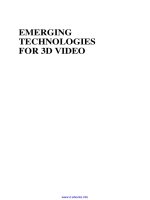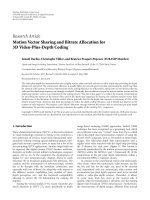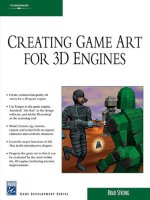emerging technologies for 3d video
Bạn đang xem bản rút gọn của tài liệu. Xem và tải ngay bản đầy đủ của tài liệu tại đây (16.71 MB, 518 trang )
EMERGING
TECHNOLOGIES
FOR 3D VIDEO
www.it-ebooks.info
www.it-ebooks.info
EMERGING
TECHNOLOGIES
FOR 3D VIDEO
CREATION, CODING, TRANSMISSION
AND RENDERING
Edited by
Fr
ed
eric Dufaux
T
el
ecom Paris Tech, CNRS, France
B
eatrice Pesquet-Popescu
T
el
ecom Paris Tech, France
Marco Cagnazzo
T
el
ecom Paris Tech, France
www.it-ebooks.info
This edition first published 2013
#
2013 John Wiley & Sons, Ltd.
Registered office
John Wiley & Sons, Ltd, The Atrium, Southern Gate, Chichester, West Sussex, PO19 8SQ, United Kingdom
For details of our global editorial offices, for customer services and for information about how to apply for permission to
reuse th e copyright material in this book please see our website at www.wiley.com.
The right of the author to be identified as the author of this work has been asserted in accordance with the Copyright,
Designs and Patents Act 1988.
All rights reserved. No part of this publication may be reproduced, stored in a retrieval system, or transmitted, in any form
or by any means, electronic, mechanical, photocopying, recording or otherwise, except as permitted by the UK Copyright,
Designs and Patents Act 1988, without the prior permission of the publisher.
Wiley also publishes its books in a variety of electronic formats. Some content that appears in print may not be available in
electronic books.
Designations used by companies to distinguish their products are often claimed as trademarks. All brand names and product
names used in this book are trade names, service marks, trademarks or registered trademarks of their respective owners. The
publisher is not associated with any product or vendor mentioned in this book.
Limit of Liability/Disclaimer of Warranty: While the publisher and author have used their best efforts in preparing this
book, they make no representations or warranties with respect to the accuracy or completeness of the contents of this book
and specifically disclaim any implied warranties of merchantability or fitness for a particular purpose. It is sold on the
understanding that the publisher is not engaged in rendering professional services and neither the publisher nor the author
shall be liable for damages arising herefrom. If professional advice or other expert assistance is required, the services of a
competent professional should be sought.
Library of Congress Cataloging-in-Publication Data
Emerging technologies for 3D video : creation, coding, transmission, and
rendering / Frederic Dufaux, Beatrice Pesquet-Popescu, Marco Cagnazzo.
pages cm
Includes bibliographical references and index.
ISBN 978-1-118-35511-4 (cloth)
1. 3-D video–Standards. 2. Digital video–Standards. I. Dufaux, Frederic,
1967- editor of compilation. II. Pesquet-Popescu, Beatrice, editor of
compilation. III. Cagnazzo, Marco, editor of compilation. IV. Title: Emerging
technologies for three dimensional video.
TK6680.8.A15E44 2013
006.6
0
96–dc23
2012047740
A catalogue record for this book is available from the British Library.
ISBN: 9781118355114
Set in 10/12pt, Times by Thomson Digital, Noida, India.
www.it-ebooks.info
Contents
Preface xvii
List of Contributors xxi
Acknowledgements xxv
PART I CONTENT CREATION
1 Consumer Depth Cameras and Applications 3
Seungkyu Lee
1.1 Introduction 3
1.2 Time-of-Flight Depth Camera 3
1.2.1 Principle 4
1.2.2 Quality of the Measured Distance 6
1.3 Structured Light Depth Camera 11
1.3.1 Principle 11
1.4 Specular and Transparent Depth 12
1.5 Depth Camera Applications 15
1.5.1 Interaction 15
1.5.2 Three-Dimensional Reconstruction 15
References 16
2 SFTI: Space-from-Time Imaging 17
Ahmed Kirmani, Andrea ColaSco, and Vivek K. Goyal
2.1 Introduction 17
2.2 Background and Related Work 18
2.2.1 Light Fields, Reflectance Distribution Fu nctions, and Optical
Image Formation 18
2.2.2 Time-of-Flight Methods for Estimating Scene Structure 20
2.2.3 Synthetic Aperture Radar for Estimating Scene Reflectance 20
2.3 Sampled Response of One Source–Sensor Pair 21
2.3.1 Scene, Illumination, and Sensor Abstractions 21
2.3.2 Scene Response Derivation 22
2.3.3 Inversion 24
2.4 Diffuse Imaging: SFTI for Estimating Scene Reflectance 24
www.it-ebooks.info
2.4.1 Response Modeling 24
2.4.2 Image Recovery using Linear Backprojection 28
2.5 Compressive Depth Acquisition: SFTI for Estimating Scene Structure 30
2.5.1 Single-Plane Response to Omnidirectional Illumination 30
2.5.2 Spatially-Patterned Measurement 32
2.5.3 Algorithms for Depth Map Reconstruction 33
2.6 Discussion and Fu ture Work 34
Acknowledgments 35
References 35
3 2D-to-3D Video Conversion: Overview and Perspectives 37
Carlos Vazquez, Liang Zhang, Filippo Speranza, Nils Plath, and Sebastian Knorr
3.1 Introduction 37
3.2 The 2D-to-3D Conversion Problem 38
3.2.1 General Conversion Approach 38
3.2.2 Depth Cues in Monoscopic Video 39
3.3 Definition of Depth Structure of the Scene 41
3.3.1 Depth Creation Methods 42
3.3.2 Depth Recovery Methods 44
3.4 Generation of the Second Video Stream 48
3.4.1 Depth to Disparity Mapping 48
3.4.2 View Synthesis and Rendering Techniques 49
3.4.3 Post-Processing for Hole-Filling 53
3.5 Quality of Experience of 2D-to-3D Conversion 56
3.6 Conclusions 57
References 58
4 Spatial Plasticity: Dual-Camera Configurations and Variable Interaxial 62
Ray Zone
4.1 Stereoscopic Capture 62
4.2 Dual-Camera Arrangements in the 1950s 63
4.3 Classic “Beam-Splitter” Technology 65
4.4 The Dual-Camera Form Factor and Camera Mobility 66
4.5 Reduced 3D Form Factor of the Digital CCD Sensor 68
4.6 Handheld Shooting with Variable Interaxial 71
4.7 Single-Body Camera Solutions for Stereoscopic Cinematography 73
4.8 A Modular 3D Rig 76
4.9 Human Factors of Variable Interaxial 76
References 78
PART II REPRESENTATION, CODING AND TRANSMISSION
5 Disparity Estimation Techniques 81
Mounir Kaaniche, Raffaele Gaetano, Marc o Cagnazzo,
and B
eatrice Pesquet-Popescu
5.1 Introduction 81
vi Contents
www.it-ebooks.info
5.2 Geometrical Models for Stereoscopic Imaging 82
5.2.1 The Pinhole Camera Model 82
5.2.2 Stereoscopic Imaging Systems 85
5.3 Stereo Matching Process 88
5.3.1 Disparity Information 88
5.3.2 Difficulties in the Stereo Matching Proce ss 88
5.3.3 Stereo Matching Constraints 89
5.3.4 Fundamental Steps Involved in Stereo Matching Algorithms 89
5.4 Overview of Disparity Estimation Methods 91
5.4.1 Local Methods 91
5.4.2 Global Methods 93
5.5 Conclusion 98
References 98
6 3D Video Repr esentation and Formats 102
Marco Cagnazzo, B
eatrice Pesquet-Popescu, and Fr
ed
eric Dufaux
6.1 Introduction 102
6.2 Three-Dimensional Video Representation 103
6.2.1 Stereoscopic 3D (S3D) Video 103
6.2.2 Multiview Video (MVV) 104
6.2.3 Video-Plus-Depth 105
6.2.4 Multiview Video-Plus-Depth (MVD) 107
6.2.5 Layered Depth Video (LDV) 107
6.3 Three-Dimensional Video Formats 109
6.3.1 Simulcast 109
6.3.2 Frame-Compatible Stereo Interleaving 110
6.3.3 MPEG-4 Multiple Auxiliary Components (MAC) 113
6.3.4 MPEG-C Part 3 113
6.3.5 MPEG-2 Multiview Profile (MVP) 113
6.3.6 Multiview Video Coding (MVC) 114
6.4 Perspectives 118
Acknowledgments 118
References 119
7 Depth Video Coding Technologies 121
Elie Gabriel Mora, Giuseppe Valenzise, Jo
€
el Jung, B
eatrice Pesquet-Popescu,
Marco Cagnazzo, and Fr
ed
eric Dufaux
7.1 Introduction 121
7.2 Depth Map Ana lysis and Characteristics 122
7.3 Depth Map Coding Tools 123
7.3.1 Tools that Exploit the Inherent Characteristics of Depth Maps 123
7.3.2 Tools that Exploit the Correlations with the Associated Texture 127
7.3.3 Tools that Optimize Depth Map Coding for the Quality
of the Synthesis 129
7.4 Application Example: Depth Map Coding Using “Don’t Care” Regions 132
7.4.1 Derivation of “Don’t Care” Regions 133
7.4.2 Transform Domain Sparsification Using “Don’t Care” Regions 134
Contents vii
www.it-ebooks.info
7.4.3 Using “Don’t Care” Regions in a Hybrid Video Codec 135
7.5 Concluding Remarks 136
Acknowledgments 137
References 137
8 Depth-Based 3D Video Formats and Coding Technology 139
Anthony Vetro and Karsten M
€
uller
8.1 Introduction 139
8.1.1 Existing Stereo/Multiview Formats 140
8.1.2 Requirements for Depth-Based Format 140
8.1.3 Chapter Organization 141
8.2 Depth Representation and Rendering 141
8.2.1 Depth Format and Representation 142
8.2.2 Depth-Image-Based Rendering 143
8.3 Coding Architectures 144
8.3.1 AVC-Based Architecture 144
8.3.2 HEVC-Based Architecture 146
8.3.3 Hybrid 146
8.4 Compression Technology 147
8.4.1 Inter-View Prediction 148
8.4.2 View Synthesis Prediction 148
8.4.3 Depth Resampling and Filterin g 149
8.4.4 Inter-Component Parameter Prediction 150
8.4.5 Depth Modelling 151
8.4.6 Bit Al location 152
8.5 Experimental Evaluation 153
8.5.1 Evaluation Framework 153
8.5.2 AVC-Based 3DV Coding Results 155
8.5.3 HEVC-Based 3DV Coding Results 156
8.5.4 General Observations 158
8.6 Concluding Remarks 158
References 159
9 Coding for Interactive Navigation in High-Dimensional Media Data 162
Ngai-Man Cheung and Gene Cheung
9.1 Introduction 162
9.2 Challenges and Approaches of Interactive Media Streaming 163
9.2.1 Challenges: Coding Efficiency and Navigation Flexibility 163
9.2.2 Approaches to Interactive Media Streaming 165
9.3 Example Solutions 166
9.3.1 Region-of-Interest (RoI) Image Browsing 166
9.3.2 Light-Field Streaming 167
9.3.3 Volumetric Image Random Access 168
9.3.4 Video Browsing 168
9.3.5 Reversible Video Playback 169
9.3.6 Region-of-Interest (RoI) Video Streaming 169
viii Contents
www.it-ebooks.info
9.4 Interactive Multiview Video Streaming 172
9.4.1 Interactive Multiview Video Streaming (IMVS) 172
9.4.2 IMVS with Free Viewpoint Navigation 179
9.4.3 IMVS with Fixed Round-Trip Delay 181
9.5 Conclusion 184
References 184
10 Adaptive Streaming of Multiview Video Over P2P Networks 187
C. G
€
oktu
gG
€
urler and A. Murat Tekalp
10.1 Introduction 187
10.2 P2P Overlay Networks 188
10.2.1 Overlay Topology 188
10.2.2 Sender-Driven versus Receiver-Driven P2P Video Streaming 189
10.2.3 Layered versus Cross-Layer Architecture 190
10.2.4 When P2P is Useful: Regions of Operation 191
10.2.5 BitTorrent: A Platform for File Sharing 191
10.3 Monocular Video Streaming Over P2P Networks 192
10.3.1 Video Coding 193
10.3.2 Variable-Size Chunk Generation 193
10.3.3 Time-Sensitive Chunk Scheduling Using Windowing 194
10.3.4 Buffer-Driven Rate Adaptation 195
10.3.5 Adaptive Window Size and Scheduling Restrictions 195
10.3.6 Multiple Requests from Multiple Peers of a Single Chunk 196
10.4 Stereoscopic Video Streaming over P2P Networks 197
10.4.1 Stereoscopic Video over Digital TV 197
10.4.2 Rate Adaptation in Stereo Streaming: Asymmetric Coding 197
10.4.3 Use Cases: Stereoscopic Video Streaming over P2P Network 200
10.5 MVV Streaming over P2P Networks 201
10.5.1 MVV Streaming over IP 201
10.5.2 Rate Adaptation for MVV: View Scal ing 201
10.5.3 Use Cases: MVV Streaming over P2P Network 202
References 203
PART III RENDERING AND SYNTHESIS
11 Image Domain Warping for Stereoscopic 3D Applications 207
Oliver Wang, Manuel Lang, Nikolce Stefanoski, Alexander Sorkine-Hornung,
Olga Sorkine-Hornung, Aljoscha Smolic, and Markus Gross
11.1 Introduction 207
11.2 Background 208
11.3 Image Domain Warping 209
11.4 Stereo Mapping 210
11.4.1 Problems in Stereoscopic Viewing 210
11.4.2 Disparity Range 210
11.4.3 Disparity Sensitivity 211
11.4.4 Disparity Velocity 211
Contents ix
www.it-ebooks.info
11.4.5 Summary 212
11.4.6 Disparity Mapping Operators 212
11.4.7 Linear Operator 212
11.4.8 Nonlinear Operator 212
11.4.9 Temporal Operator 213
11.5 Warp-Based Disparity Mapping 213
11.5.1 Data Extraction 213
11.5.2 Warp Calculation 214
11.5.3 Applications 216
11.6 Automatic Stereo to Multiview Conversion 218
11.6.1 Automatic Stereo to Multiview Conversion 218
11.6.2 Position Constraints 219
11.6.3 Warp Interpolation and Extrapolation 219
11.6.4 Three-Dimensional Video Transmission Systems
for Multiview Displays 220
11.7 IDW for User-Driven 2D–3D Conversion 221
11.7.1 Technical Challenges of 2D–3D Conversion 222
11.8 Multi-Perspective Stereoscopy from Light Fields 225
11.9 Conclusions and Outlook 228
Acknowledgments 229
References 229
12 Image-Based Rendering and the Sampling of the Plenoptic Function 231
Christopher Gilliam, Mike Brookes, and Pier Luigi Dragotti
12.1 Introduction 231
12.2 Parameterization of the Plenoptic Function 232
12.2.1 Light Field and Surface Light Field Parameterization 232
12.2.2 Epipolar Plane Image 234
12.3 Uniform Sampling in a Fourier Framework 235
12.3.1 Spectral Analysis of the Plenoptic Function 236
12.3.2 The Plenoptic Spectrum under Realistic Conditions 239
12.4 Adaptive Plenoptic Sampling 242
12.4.1 Adaptive Sampling Based on Plenoptic Spectral Analysis 244
12.5 Summary 246
12.5.1 Outlook 246
References 247
13 A Framework for Image-Based Stereoscopic View Synthesis from
Asynchronous Multiview Data 249
Felix Klose, Christian Lipski, and Marcus Magnor
13.1 The Virtual Video Camera 249
13.1.1 Navigation Space Embedding 251
13.1.2 Space–Time Tetrahedralization 252
13.1.3 Processing Pipeline 255
13.1.4 Rendering 256
13.1.5 Application 257
13.1.6 Limitations 258
x Contents
www.it-ebooks.info
13.2 Estimating Dense Image Corresponde nces 258
13.2.1 Belief Propagation for Image Correspondences 259
13.2.2 A Symmetric Extension 260
13.2.3 SIFT Descriptor Downsampling 261
13.2.4 Construction of Message-Passing Graph 261
13.2.5 Data Term Compression 262
13.2.6 Occlusion Removal 263
13.2.7 Upsampling and Refinement 263
13.2.8 Limitations 263
13.3 High-Quality Correspondence Edit 264
13.3.1 Editing Operations 264
13.3.2 Applications 265
13.4 Extending to the Third Dimension 265
13.4.1 Direct Stereoscopic Virtual View Synthesis 266
13.4.2 Depth-Image-Based Rendering 267
13.4.3 Comparison 267
13.4.4 Concluding with the “Who Cares?” Post-Production Pipeline 268
References 270
PART IV DISPLAY TECHNOLOGIES
14 Signal Processing for 3D Displays 275
Janusz Konrad
14.1 Introduction 275
14.2 3D Content Generation 276
14.2.1 Automatic 2D-to-3D Image Conversion 276
14.2.2 Real-Time Intermediate View Interpolation 280
14.2.3 Brightness and Color Balancing in Stereopa irs 286
14.3 Dealing with 3D Display Hardware 287
14.3.1 Ghosting Suppression for Polarized and Shuttered
Stereoscopic 3D Displays 287
14.3.2 Aliasing Suppression for Multiview Eyewear-Free 3D Displays 289
14.4 Conclusions 292
Acknowledgments 293
References 293
15 3D Display Technologies 295
Thierry Borel and Didier Doyen
15.1 Introduction 295
15.2 Three-Dimensional Display Technologies in Cinemas 295
15.2.1 Three-Dimensional Cinema Projectors Based on Light
Polarization 296
15.2.2 Three-Dimensional Cinema Projectors Based on Shutters 299
15.2.3 Three-Dimensional Cinema Projectors Based on
Interference Filters 300
15.3 Large 3D Display Technologies in the Home 301
15.3.1 Based on Anaglyph Glasses 301
Contents xi
www.it-ebooks.info
15.3.2 Based on Shutter Glasses 302
15.3.3 Based on Polarized Glasses 304
15.3.4 Without Glasses 306
15.4 Mobile 3D Display Technologies 309
15.4.1 Based on Parallax Barriers 310
15.4.2 Based on Lighting Switch 310
15.5 Long-Term Perspectives 311
15.6 Conclusion 312
References 312
16 Integral Imaging 313
Jun Arai
16.1 Introduction 313
16.2 Integral Photography 314
16.2.1 Principle 314
16.2.2 Integral Photography with a Concave Lens Array 315
16.2.3 Holocoder Hologram 317
16.2.4 IP using a Retrodirective Screen 318
16.2.5 Avoiding Pseudoscopic Images 318
16.3 Real-Time System 319
16.3.1 Orthoscopic Conversion Optics 319
16.3.2 Applications of the Ultra-High-Resolution Video System 322
16.4 Properties of the Reconstructed Image 325
16.4.1 Geometrical Relationship of Subject and Sp atial Image 325
16.4.2 Resolution 326
16.4.3 Viewing Area 329
16.5 Research and Development Trends 330
16.5.1 Acquiring and Displaying Spatial Information 330
16.5.2 Elemental Image Generation from 3D Object Information 331
16.5.3 Three-Dimensional Measurement 332
16.5.4 Hologram Conversion 333
16.6 Conclusion 334
References 334
17 3D Light-Field Display Technologies 336
P
eter Tam
as Kov
acs and Tibor Balogh
17.1 Introduction 336
17.2 Fundamentals of 3D Displaying 337
17.3 The HoloVizio Light-Field Display System 339
17.3.1 Design Principles and System Parameters 340
17.3.2 Image Organization 341
17.4 HoloVizio Displays and Applications 342
17.4.1 Desktop Displays 342
17.4.2 Large-Scale Displays 343
17.4.3 Cinema Display 343
17.4.4 Software and Content Creation 344
17.4.5 Applications 344
xii Contents
www.it-ebooks.info
17.5 The Perfect 3D Display 345
17.6 Conclusions 345
References 345
PART V HUMAN VISUAL SYSTEM AN D QUALITY ASSESSMENT
18 3D Media and the Human Visual System 349
Simon J. Watt and Kevin J. MacKenzie
18.1 Overview 349
18.2 Natural Viewing and S3D Viewing 349
18.3 Perceiving 3D Structure 350
18.3.1 Perceiving Depth from Binocular Disparity 352
18.4 ‘Technical’ Issues in S3 D Viewing 354
18.4.1 Cross-Talk 355
18.4.2 Low Image Luminanc e and Contrast 355
18.4.3 Photometric Differences Between Left - and Right-Eye Images 355
18.4.4 Camera Misalignments and Differences in Camera Optics 356
18.4.5 Window Violations 356
18.4.6 Incorrect Specular Highlights 356
18.5 Fundamental Issues in S3D Viewing 357
18.6 Motion Artefacts from Field-Sequential Stereoscopic Presentation 357
18.6.1 Perception of Flicker 359
18.6.2 Perception of Unsmooth or Juddering Motion 359
18.6.3 Distortions in Perceived Depth from Binocular Disparity 360
18.6.4 Conclusions 360
18.7 Viewing Stereoscopic Images from the ‘Wrong’ Place 361
18.7.1 Capture Parameters 361
18.7.2 Display Parameters and Viewer Parameters 364
18.7.3 Are Problems of Incorrect Geometry Unique to S3D? 364
18.7.4 Conclusions 366
18.8 Fixating and Focusing on Stereoscopic Images 366
18.8.1 Accommodation, Vergence and Viewing Distance 367
18.8.2 Accommodation and Vergence in the Real World and in S3D 367
18.8.3 Correcting Focus Cues in S3D 368
18.8.4 The Stereoscopic Zone of Comfort 369
18.8.5 Specifying the Zone of Comfort for Cinematography 370
18.8.6 Conclusions 371
18.9 Concluding Remarks 372
Acknowledgments 372
References 372
19 3D Video Quality Assessment 377
Philippe Hanhart, Francesca De Simone, Martin Rerabek,
and Touradj Ebrahimi
19.1 Introduction 377
19.2 Stereoscopic Artifacts 378
Contents xiii
www.it-ebooks.info
19.3 Subjective Quality Assessment 379
19.3.1 Psycho-perceptual (or Psychophysical) Experiments 380
19.3.2 Descriptive (or Explorative) Approaches 382
19.3.3 Hybrid Approaches 382
19.3.4 Open Issues 383
19.3.5 Future Directions 384
19.4 Objective Quality Assessment 384
19.4.1 Objective Quality Metrics 384
19.4.2 From 2D to 3D 385
19.4.3 Including Depth Information 386
19.4.4 Beyond Image Quality 387
19.4.5 Open Issues 388
19.4.6 Future Directions 389
References 389
PART VI APPLICATIONS AND IMPLEMENTATION
20 Interactive Omnidirectional Indoor Tour 395
Jean-Charles Bazin, Olivier Saurer , Friedrich Fraundorfer, and Marc Pollefeys
20.1 Introduction 395
20.2 Related Work 396
20.3 System Overview 397
20.4 Acquisition and Preprocessing 398
20.4.1 Camera Model 398
20.4.2 Data Acquisition 400
20.4.3 Feature Extraction 401
20.4.4 Key-Frame Selection 401
20.5 SfM Using the Ladybug Camera 401
20.6 Loop and Junction Detection 401
20.7 Interactive Alignment to Floor Plan 402
20.7.1 Notation 402
20.7.2 Fusing SfM with Ground Control Points 403
20.8 Visualization and Navigation 405
20.8.1 Authoring 405
20.8.2 Viewer 405
20.9 Vertical Rectification 408
20.9.1 Existing Studies 408
20.9.2 Procedure Applied 408
20.9.3 Line Extraction 408
20.9.4 Line Clustering and VP Estimation 409
20.10 Experiments 410
20.10.1 Vertical Rectification 410
20.10.2 Trajectory Estimation and Mapping 411
20.11 Conclusions 414
Acknowledgments 414
References 414
xiv Contents
www.it-ebooks.info
21 View Selection 416
Fahad Daniyal and Andrea Cavallaro
21.1 Introduction 416
21.2 Content Analysis 417
21.2.1 Pose 417
21.2.2 Occlusions 419
21.2.3 Position 419
21.2.4 Size 421
21.2.5 Events 421
21.3 Content Ranking 421
21.3.1 Object-Centric Quality of View 422
21.3.2 View-Centric Quality of View 423
21.4 View Selection 424
21.4.1 View Selection as a Scheduling Problem 425
21.4.2 View Selection as an Optimization Problem 425
21.5 Comparative Summary and Outlook 426
References 429
22 3D Video on Mobile Devices 432
Arnaud Bourge and Alain Bellon
22.1 Mobile Ecosystem, Architecture, and Requirements 432
22.2 Stereoscopic Applications on Mobile Devices 433
22.2.1 3D Video Camcorder 434
22.2.2 3D Video Player 434
22.2.3 3D Viewing Modalities 434
22.2.4 3D Graphics Applications 435
22.2.5 Interactive Video Applications 435
22.2.6 Monoscopic 3D 435
22.3 Stereoscopic Capture on Mobile Devices 436
22.3.1 Stereo-Camera Design 436
22.3.2 Stereo Imaging 437
22.3.3 Stereo Rectification, Lens Distortion, and Camera
Calibration 438
22.3.4 Digital Zoom and Video Stabilization 440
22.3.5 Stereo Codecs 442
22.4 Display Rendering on Mobile Devices 442
22.4.1 Local Auto-Stereoscopic Display 442
22.4.2 Remote HD Display 443
22.4.3 Stereoscopic Rendering 443
22.5 Depth and Dispar ity 445
22.5.1 View Synthesis 445
22.5.2 Depth Map Representation and Compression Standards 446
22.5.3 Other Usages 447
22.6 Conclusions 448
Acknowledgments 448
References 448
Contents xv
www.it-ebooks.info
23 Graphics Composition for Multiview Displays 450
Jean Le Feuvre and Yves Mathieu
23.1 An Interactive Compos ition System for 3D Displays 450
23.2 Multimedia for Multiview Displays 451
23.2.1 Media Formats 451
23.2.2 Multimedia Languages 452
23.2.3 Multiview Displays 453
23.3 GPU Graphics Synthesis for Multiview Displays 454
23.3.1 3D Synthesis 454
23.3.2 View Interleaving 455
23.3.3 3D Media Rendering 457
23.4 DIBR Graphics Synthesis for Multiview Displays 458
23.4.1 Quick Overview 458
23.4.2 DIBR Synthesis 459
23.4.3 Hardware Compositor 460
23.4.4 DIBR Pre- and Post-Processing 462
23.4.5 Hardware Platform 464
23.5 Conclusion 466
Acknowledgments 466
References 466
24 Real-Time Disparity Estimation Engine for High-Definition 3DTV
Applications 468
Yu-Cheng Tseng and Tian-Sheuan Chang
24.1 Introduction 468
24.2 Review of Disparity Estimation Algorithms and Implementations 469
24.2.1 DP-Based Algorithms and Implementations 469
24.2.2 GC-Based Algorithms and Implementations 470
24.2.3 BP-Based Algorithms and Implementations 470
24.3 Proposed Hardware-Efficient Algorithm 471
24.3.1 Downsampled Matching Cost for Full Disparity Range 472
24.3.2 Hardware-Efficient Cost Diffusion Method 472
24.3.3 Upsampling Disparity Maps 473
24.3.4 Temporal Consistency Enhancement Methods 474
24.3.5 Occlusion Handling 475
24.4 Proposed Architecture 476
24.4.1 Overview of Architecture 476
24.4.2 Computational Modules 477
24.4.3 External Memory Access 478
24.5 Experimental Results 479
24.5.1 Comparison of Disparity Quality 479
24.5.2 Analysis of Sampling Factor 480
24.5.3 Implementation Result 481
24.6 Conclusion 483
References 483
Index 487
xvi Contents
www.it-ebooks.info
Preface
The underlying principles of stereopsis have been known for a long time. Stereoscopes to see
photographs in 3D appeared and became popular in the nineteenth century. The first demon-
strations of 3D movies took place in the first half of the twentieth century, initially using
anaglyph glasses, and then with polarization-based projection. Hollywood experienced a first
short-lived golden era of 3D movies in the 1950s. In the last 10 years, 3D has regained sig-
nificant interests and 3D movies are becoming ubiquitous. Numerous major productions are
now released in 3D, culminating with Avatar, the highest grossing film of all time.
In parallel w it h the recent g rowth of 3D movies, 3DTV is attracting significant interest
from manufacturers and service providers. This is obvious by the multiplication of new 3D
product announcements and services. Beyond entertainment, 3D imaging technology is also
seen as instrume ntal in other application areas such as video games, immersive video confer-
ences, medicine, video surveillance, and engineering.
With this growing interest, 3D video is often considered as one of the major upcoming
innovations in video technol ogy, with the expectation of greatly enhanced user experience.
This book intends to provide an overview of key technologies for 3D video applications.
More specifically, it covers the state of the art and explores new research directions, with the
objective to tackle all aspects involved in 3D video systems and services. Topics addressed
include content acquisition and creation, data representation and coding, transmission, view
synthesis, rendering, display technologies, human perception of depth, and quality assess-
ment. Relevant standardization efforts are reviewed. Finally, applications and implementa-
tion issues are also described.
More specifically, the book is composed of six parts. Part One addresses dif ferent aspects of
3D content acquisition and creation. In Chapter 1, Lee presents depth cameras and related
applications. The principle of active depth sensing is reviewed, along with depth image
processing methods such as noise modelling, upsampling, and removing motion blur. In Chap-
ter 2, Kirmani, ColaSco, and Goyal introduce the space-from-time imaging frame work, which
achieves s patial resolution, in two and three dimensions, by measuring temporal v ariations of
light intensity in response to temporally or spatiotemporally v arying illumination. Chapter 3, by
Vazquez, Zhang, Speranza, Plath, and Knorr, provides an overvie w of the process generating a
stereoscopic video (S3D) from a monoscopic video source (2D), generally known as 2D-to-3D
video con v ersion, with a focus on selected recent techniques. Finally, in Chapter 4, Zone
Ã
pro-
vides an overview of numerous contemporary strategies for shooting narrow and variable inter -
axial baseline for stereoscopic cinematography. Artistic implications are also discussed.
A key issue in 3D video, Part Two addresses data representation, compression, and trans-
mission. In C hapter 5, Kaaniche, Gaetano, Cagnazzo, and Pesquet-Popescu address the
Ã
It is with great sadness that we learned that Ray Zone passed away on November 13, 2012.
www.it-ebooks.info
problem of disparity estimation. The geometrical relationship between the 3D scene and the
generated stereo images is analyzed and the most important techniques for disparity estima-
tion are reviewed. Cagnazzo, Pesquet-Popescu, and Dufaux give an overview of existing data
representation and coding formats for 3D video content in Chapter 6. In turn, in Chapter 7,
Mora, Valenzise, Jung, Pesquet-Popescu, Cagnazzo, and D ufaux consider the problem of
depth map coding and present an overview of different coding tools. In Chapter 8, Vetro and
M
€
uller provide an overview of the current status of research and standardization act ivity
towards defining a new set of depth-based formats that facilitate the generation of intermedi-
ate views with a compact binary representation. In Chapter 9, Cheung and Cheung consider
interactive media streaming, where the server continuously and reactively sends appropriate
subsets of media data in response to a client’s periodic requests. Different associated coding
strategies and solutions are reviewed. Finally, G
€
urler and Tekalp propose an adaptive P2P
video streaming solution for streaming multiview video over P2P overlays in Chapter 10.
Next, Part Three of the book discusses view synthesis and rendering. In Chapter 11, Wang,
Lang, Stefanoski, Sorkine-Hornung, Sorkine-Hornung, Smolic, and Gross present image-
domain warping as an alternative to depth-image-based rendering techniques. This technique
utilizes simpler, image-based deformations as a means for realizing various stereoscopic
post-processing operators. Gilliam, Brookes, and Dragotti, in Chapter 12, examine the state
of the art in plenoptic sampling theory. In particular, the chapter presents theoretical results
for uniform sampling based on spectra l analysis of the plenoptic function and algorithms for
adaptive plenoptic sampling. Finally, in Chapter 13, Klose, Lipski, and Magnor present a
complete end-to-end framework for stereoscopic free viewpoint video creation, allowing one
to viewpoint-navigate through space and time of complex real-world, dynamic scenes.
As a very important component of a 3D video system, Part Four focuses on 3D display
technologies. In Chapter 14, Konrad addresses digital signal processing methods for 3D data
generation, both stereoscopic and multiview, and for compensation of the deficiencies of
today’s 3D displays. Numerous experimental results are presented to demonstrate the useful-
ness of such methods. Borel and Doyen, in Chapter 15, present in detail the main 3D display
technologies available for cinemas, for large-display TV sets, and for mobile terminals. A
perspective of evolution for the near a nd long ter m is also propos ed. In Chapter 1 6, Arai
focuses on integral imaging, a 3D photography technique that is based on integral photogra-
phy, in which information on 3D space is acquired and represented. This chapter describes
the technology for displaying 3D space as a spatial image by integral imaging. Finally, in
Chapter 17, Kov
acs and Balogh present light-field displays, an advanced technique for
implementing glasses-free 3D displays.
In most targeted applications, humans are the end-users of 3D video systems. Part Five
considers human perception of depth and percept ual quality assessment. More specifically,
in Chapter 18, Watt and MacKenzie focus on how the human visual system interacts with
stereoscopic 3D media, in v iew of opt imizing effectiveness and viewing comfort. Three
main issues are addressed: incorrect spatiotemporal stimuli introduced by field-sequential
stereo presentation, inappropriate binocular viewing geometry, and the unnatural relationship
between where the eyes fixate and focus in stereoscopic 3D viewing. In turn, in Chapter 19,
Hanhart, De Simone, Rerabek, and Ebrahimi consider mechanisms of 3D vision in humans,
and their underlying perceptual models, in conjunction with the types of distortions that
today’s and tomorr ow’s 3D video processing systems produce. This compl ex puzzle is
examined with a focus on how to measure 3D visual quality, as an essential factor in the
success of 3D technologies, products, and services.
xviii Preface
www.it-ebooks.info
In order to complete the book, Part Six describes target applications for 3D video, as well
as implementation issues. In Chapter 20, Bazin, Saurer, Fraundorfer, and Pollefeys present a
semi- automatic method to generate interactive virtual tours from omnidirectional video. It
allows a user to virtually navigate through buildings and indoor scenes. Such a system can
be applied in various contexts, such as virtual tourism , tele-imm ersion, tele-presence, and
e-heritage. Daniyal and Cavallaro address the question of how to automatically i dentify
which view is more useful when observing a dynamic scene with multiple cameras in
Chapter 21. T his problem concerns several applications ranging f r om video production to
video surveillance. In particular, an overview of existing approaches for view selection and
automated video production is presented. In Chapter 22, Bourge and Bellon present the hard-
ware architecture of a typical mobile platform, and describe major stereoscopic 3D applica-
tions. Indeed, smartphones bring new opportunities to stereoscopic 3D, but also specific
constraints. Chapter 23, by Le Feuvre and Mathieu, presents an integrated system for dis-
playing interactive applications on multiview screens. Both a simple GPU-based prototype
and a low-cost hardware design implemented on a field-programmable gate array are pre-
sented. Finally, in Chapter 24, Tseng and Chang propose an optimized disparity estimation
algorithm for high-definition 3DTV applications with reduced computational and memory
requirements.
By covering general and advanced topics, providin g at the same time a broad and deep
analysis, the book has the ambition to become a reference for those involved or interested in
3D video systems and services. Assuming fundamental knowledge in image/video process-
ing, as well as a basic understanding in mathematics, this book should be of interest to a
broad readership with different backgrounds and expectations, including professors, graduate
and undergraduate students, researchers, engineers, practitioners, and managers making
technological decisions about 3D video.
Fr
ed
eric Dufaux
B
eatrice Pesquet-Popescu
Marco Cagnazzo
Preface xix
www.it-ebooks.info
www.it-ebooks.info
List of Contributors
Jun Arai, NHK (Japan Broadcasting Corporation), Japan
Tibor Balogh, Holografika, Hungary
Jean-Charles Bazin, Computer Vision and Geometry Group, ETH Z
€
urich,
Switzerland
Alain Bellon, STMicroelectronics, France
Thierry Borel, Technicolor, France
Arnaud Bourge, STMicroelectronic s, France
Mike Brookes, Department of Electrical and Electronic Engineering, Imperial College
London, UK
Marco Cagnazzo,D
epartement Traitement du Signal et des Images, T
el
ecom ParisTech,
France
Andrea Cavallaro, Queen Mary University of London, UK
Tian-Sheuan Chang, Department of Electronics Engineering, National Chiao Tung
University, Taiwan
Gene Cheung, Digital Content and Media Sciences Research Division, National Institute
of Informatics, Japan
Ngai-Man Cheung, Information Systems Technology and Design Pillar, Singapore
University of Technology and Design, Singapore
Andrea ColaSco, Media Lab, Massachusetts Institute of Technology, USA
Fahad Daniyal, Queen Mary University of London, UK
Francesca De Simone, Multimedia Signal Processing Group (MMSPG),
Ecole Polytechnique F
ed
erale de Lausanne (EPFL), Switzerland
Didier Doyen, Technicolor, France
Pier Luigi Dragotti, Department of Electrical and Electronic Engineering, Imperial
College London, UK
Fr
ed
eric Dufaux,D
epartement Traitement du Signal et des Images, T
el
ecom ParisTech,
France
www.it-ebooks.info
Touradj Ebrahimi, Multimedia Signal Processing Group (MMSPG), Ecole Polytechnique
F
ed
erale de Lausanne (EPFL), Switzerland
Friedrich Fraundorfer, Computer Vision and Geometry Group, ETH Z
€
urich,
Switzerland
Raffaele Gaetano,D
epartement T r aitement du Signal et des Images, T
el
ecom ParisTech,
France
Christopher Gilliam, Department of Electrical and Electronic Engineering, Imperial
College London, UK
Vivek K. Goyal, Research Laboratory of Electronics, Massachusetts Institute of
Technology, USA
Markus Gross, Disney Research Zurich, Switzerland
C. G
€
oktu
gG
€
urler, College of Engineering, KoSc University, Turkey
Philippe Hanhart, Multimedia Signal Processing Group (MMSPG), Ecole Polytechnique
F
ed
erale de Lausanne (EPFL), Switzerland
Alexander Sorkine-Hornung, Disney Research Zurich, Switzerland
Jo
€
el Jung, Orange Labs, France
Mounir Kaaniche,D
epartement Traitement du Signal et des Images, T
el
ecom ParisTech,
France
Ahmed Kirmani, Research Laboratory of Electronic s, Massachusetts Institute of
Technology, USA
Felix Klose, Institut f
€
ur Computergraphik, TU Braunschweig, Germany
Sebastian Knorr, imcube labs GmbH, Technische Universit
€
at Berlin, Germany
Janusz Konrad, Department of Electrical and Computer Engineering, Boston University,
USA
P
eter Tam
as Kov
acs, Holografika, Hungary
Manuel Lang, Disney Research Zurich, Switzerland
Seungkyu Lee, Samsung Advanced Institute of Technology, South Korea
Jean Le Feuvre ,D
epartement Traitement du Signal et des Images, Telecom ParisTech,
France
Christian Lipski, Institut f
€
ur Computergraphik, TU Braunschweig, Germany
Kevin J. MacKenzie, Wolfson Centre for Cognitive Neu roscience, School of Psychology,
Bangor University, UK
Marcus Magnor, Institut f
€
ur Computergraphik, TU Braunschweig, Germany
Yves Mathieu, Telecom ParisTech, France
Elie Gabriel Mora, Orange Labs, France; D
epartement Traitement du Signal et des Images,
T
el
ecom ParisTech, France
xxii List of Contributors
www.it-ebooks.info
Karsten M
€
uller, Fraunhofer Institute for Telecommunications, Heinrich-Hertz-Institut,
Germany
B
eatrice Pesquet-Popescu,D
epartement Traitement du Signal et des Images, T
el
ecom
ParisTech, France
Nils Plath, imcube labs GmbH , Technische Universit
€
at Berlin, Germany
Marc Pollefeys, Computer Vision and Geometry Group, ETH Z
€
urich, Switzerland
Martin Rerabek, Multimedia Signal Processing Group (MMSPG), Ecole Polytechnique
F
ed
erale de Lausanne (EPFL), Switzerland
Olivier Saurer, Computer Vision and Geometry Group, ETH Z
€
urich, Switzerland
Aljoscha Smolic, Disney Research Zurich, Switzerland
Olga Sorkine-Hornung, ETH Zurich, Switzerland
Filippo Speranza, Communications Research Centre Canada (CRC), Canada
Nikolce Stefanoski, Disney Research Zurich, Switzerland
A. Murat Tekalp , College of Engineering, KoSc University, Turkey
Yu-Cheng Tseng, Department of Electronics Engineering, National Chiao Tung University,
Taiwan
Giuseppe Valenzise,D
epartement Traitement du Signal et des Images, T
el
ecom ParisTech,
France
Carlos Vazquez, Communications Research Centre Canada (CRC), Canada
Anthony Vetro, Mitsubishi Electric Research Labs (MERL), USA
Simon J. Watt, Wolfson Centre for Cognitive Neurosc ience, School of Psychology, Bangor
University, UK
Oliver Wang, Disney Research Zurich, Switzerland
Liang Zhang, Communications Research Centre Ca nada (CRC), Canada
Ray Zone, The 3-D Zone, USA
List of Contributors xxiii
www.it-ebooks.info
www.it-ebooks.info
Acknowledgements
We would like to express our deepest appreciation to all the authors for their invaluable
contributions. Without their commitment and efforts, this book would not have been
possible.
Moreover, we would like to gratefully acknowledge the John Wiley & Sons Ltd. staff,
Alex King, Liz Wingett, Rich ard Davies, and Genna Ma naog , for their relentless supp or t
throughout this endeavour.
Fr
ed
eric Dufaux
B
eatrice Pesquet-Popescu
Marco Cagnazzo
www.it-ebooks.info









